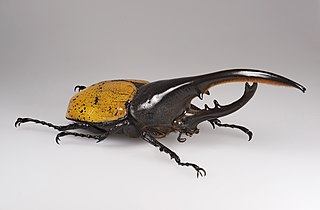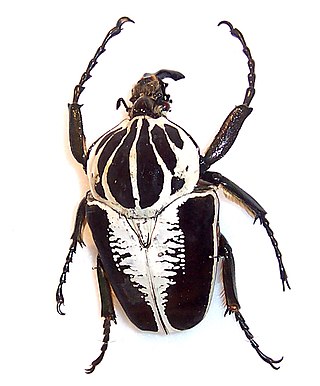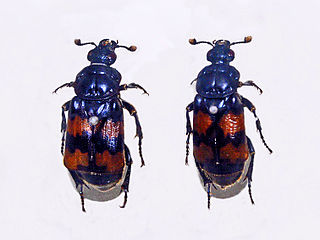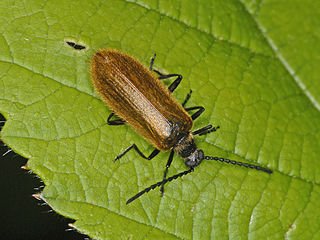
Histeridae is a family of beetles commonly known as clown beetles or Hister beetles. This very diverse group of beetles contains 3,900 species found worldwide. They can be easily identified by their shortened elytra that leaves two of the seven tergites exposed, and their geniculate (elbowed) antennae with clubbed ends. These predatory feeders are most active at night and will fake death if they feel threatened. This family of beetles will occupy almost any kind of niche throughout the world. Hister beetles have proved useful during forensic investigations to help in time of death estimation. Also, certain species are used in the control of livestock pests that infest dung and to control houseflies. Because they are predacious and will even eat other Hister beetles, they must be isolated when collected.

The Hercules beetle is a species of rhinoceros beetle native to the rainforests of Central America, South America, and the Lesser Antilles. It is the longest extant species of beetle in the world, and is also one of the largest flying insects in the world.

The Goliath beetles are any of the five species in the genus Goliathus. Goliath beetles are among the largest insects on Earth, if measured in terms of size, bulk and weight. They are members of subfamily Cetoniinae, within the family Scarabaeidae. Goliath beetles can be found in many of Africa's tropical forests, where they feed primarily on tree sap and fruit. Little appears to be known of the larval cycle in the wild, but in captivity, Goliathus beetles have been successfully reared from egg to adult using protein-rich foods such as commercial cat and dog food. Goliath beetles measure from 60–110 millimetres (2.4–4.3 in) for males and 50–80 millimetres (2.0–3.1 in) for females, as adults, and can reach weights of up to 80–100 grams (2.8–3.5 oz) in the larval stage, though the adults are only about half this weight. The females range from a dark chestnut brown to silky white, but the males are normally brown/white/black or black/white.

Goliathus orientalis is a species of beetles belonging to the family Scarabaeidae.

Nicrophorus vestigator is a species of beetle belonging to the family Silphidae.

Galeruca tanaceti is a species of leaf beetle found in the Palearctic realm, and is the type species of the genus Galeruca. It was first described by Carl Linnaeus in his 1758 10th edition of Systema Naturae.

Arima marginata is a species of leaf beetles of the subfamily Galerucinae in the family Chrysomelidae.

Clytra laeviuscula, the ant bag beetle, is a species of short-horned leaf beetles belonging to the family Chrysomelidae, subfamily Cryptocephalinae.

Cryptocephalus sericeus is a species of beetle of the family Chrysomelidae, subfamily Cryptocephalinae.

Stenurella melanura is a flower longhorn beetle species of the family Cerambycidae, subfamily Lepturinae.

Drilus flavescens is a species of beetles belonging to the family Drilidae.

Lagria hirta is a species of beetles in the family Tenebrionidae.

Cicindela albissima, commonly called the Coral Pink Sand Dunes tiger beetle is a species of tiger beetle endemic to Coral Pink Sand Dunes State Park in southern Utah, United States. It was originally described by Rumpp in 1962 as the subspecies Cicindela limbata albissima, but mitochondrial DNA, along with the species' morphological and geographical distinctiveness, have shown that it is a separate species. C. albissima can be distinguished from other Cicindela species by its restricted range and lack of pigmentation on its elytra.

Micrelytra fossularum is a species of European bugs belonging to the family Alydidae and type genus of the tribe Micrelytrini. It is the only representative of the monotypic genus Micrelytra.

Chlorophorus varius, the grape wood borer, is a species of beetle in the family Cerambycidae.

Lampyris raymondi is a firefly species of the genus Lampyris, belonging to the order Coleoptera.

Araecerus fasciculatus, the coffee bean weevil, is a species of beetle belonging to the family Anthribidae. Despite its name, it affects a wide range of stored products and some field crops. Through trade it has become cosmopolitan in its distribution.

Cerambyx welensii is a species of beetle in the family Cerambycidae.

Oedemera crassipes is a species of beetle belonging to the family Oedemeridae subfamily Oedemerinae.

Mylabris variabilis is a species of blister beetle belonging to the Meloidae family.




















